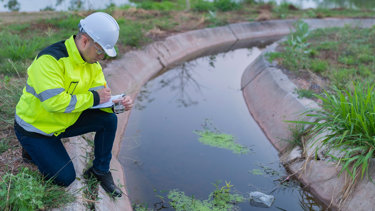The Environment Agency’s new Chief Regulator: Preparing for stricter oversight
Published: 12 February 2025
The Chief Regulator's first annual report for 2023/24 has been published, highlighting a renewed focus on compliance. This report comes at a critical time, as the Environment Agency recorded 561 serious pollution incidents (Category 1 and 2) in England during this period, averaging nearly two per day.

It’s a shocking statistic, but one that goes some way in explaining the Environment Agency’s recent introduction of the new Chief Regulator and the implications for businesses with environmental permits. It’s further confirmation that the direction and pace of compliance change are unmistakably moving in one direction: towards increased scrutiny and enforcement.
For businesses, staying ahead of the compliance curve necessitates comprehensive, multi-disciplinary planning and investment. And while compliance is crucial, its positive impacts extend to enhancing environmental performance and contributing to sustainability objectives.
Resourcing enforcement
Environmental pollution remains a high priority for the public but the Environment Agency, as well as other regulators across the UK, has found it difficult to sustain resources to meet the enforcement challenges. This lack of resources may have led to a degree of complacency with regards to environmental management practices. However, this trend is set to reverse dramatically with new investment and the introduction of the Chief Regulator role.
The role of the Chief Regulator
The role of the Chief Regulator is to make sure that the Environment Agency is ‘a future-focused, effective regulator, supporting innovation but protecting and improving our environment’. In practical terms, it involves commenting on performance and setting operational standards.
The Chief Regulator's first annual report for 2023/24 highlights a renewed focus on compliance, with over 20,000 compliance assessments conducted, including approximately 9,000 direct inspections. Notably, 93% of inspected EPR permits were in the top two categories of good performance, while 2.7% were in the worst environmental performance categories.
The Chief Regulator emphasised that "our regulation must also have teeth – we need to take firm action against those whose performance falls below standard, so that they improve, are held to account and do not gain advantage from cutting corners."

With the Chief Regulator's oversight, there will be an increased regulatory focus on businesses with Environmental Agency permits. This shift has largely been driven by public concerns over issues such as sewerage spills and water company performance.
The importance of multi-disciplinary planning
Achieving and maintaining compliance with environmental regulations demands comprehensive planning and investment across multiple disciplines. To ensure robust environmental performance, meet permit conditions, and contribute significantly towards their sustainability goals, businesses must identify and address specific vulnerabilities, develop targeted strategies, and allocate the necessary resources.
To operate legally and compliantly, having expert support at hand is crucial in assessing site conditions, monitoring groundwater and site discharges, and remediating soil and groundwater when necessary. In the event of receiving an improvement notice or information request notice, such as Regulation 61, additional monitoring, sampling, or remediation may also be required.
By prioritising environmental performance, businesses can streamline their processes, leading to greater operational efficiency and reduced business disruption. Proactive environmental management minimises the risk of incidents, which could otherwise result in costly fines and damage to reputation. Strong environmental performance also supports environmental, social, and governance (ESG) goals, enhancing a company's appeal to investors and customers who prioritise sustainability. This helps in meeting regulatory requirements and positions businesses as leaders in environmental responsibility, providing a significant competitive advantage in today's market.
“However, our regulation must also have teeth – we need to take firm action against those whose performance falls below standard, so that they improve, are held to account and do not gain advantage from cutting corners. There must be a level playing field for those who do comply.”
Dr Jo Nettleton
Chief Regulator, Environment Agency
How we can help
An environmental permit is there to help your business operate responsibly while safeguarding the environment.
We are uniquely positioned to support you with all your environmental needs, thanks to our unparalleled blend of environmental consulting, infrastructure lifecycle management expertise, and award-winning pollution response capabilities. Whether it's permit application, ongoing compliance, or relinquishing a permit, we have the expertise to assist every step of the way.
Our proactive approach and close collaboration with regulators ensure we stay ahead of regulatory changes and contribute to shaping effective and resilient policies. As the Environment Agency’s Chief Regulator stated, "Long-term, we need to transform our regulation to ensure we are effective and resilient through the decades ahead." By working together with regulatory bodies, we support you in navigating the complexities of compliance, driving innovation, and enhancing environmental performance.
Adapting to heightened environmental scrutiny
The landscape of environmental compliance is changing rapidly, with increased enforcement and regulatory focus. And public opinion on environmental responsibility is becoming increasingly vocal. Businesses must adapt by adopting a proactive, multi-disciplinary approach to environmental management. By understanding the evolving regulatory environment and responding to public expectations, companies can not only stay compliant but also gain a competitive edge in a world where environmental performance is under greater scrutiny.
More from our Knowledge Hub
 Insights
InsightsEarth Day 2025: Enabling a sustainable future while supporting today’s infrastructure in an evolving energy landscape
 Insights
InsightsMitigating climate change risks through planned preventive maintenance
 Insights
InsightsProtective coatings: Safeguarding infrastructure against climate change
 Insights
InsightsDelivering the Water (Special Measures) Act: Supporting compliance and innovation
Environmental compliance today, creating a sustainable tomorrow
Helping you reduce risk to the environment and your operation by managing assets compliantly while achieving commercial, ESG, and net-zero goals.
Contact our experts
